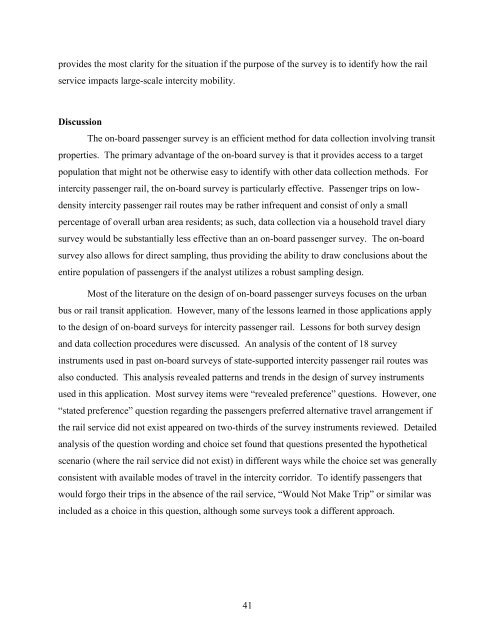Measuring the Benefits of Intercity Passenger Rail: A Study
Measuring the Benefits of Intercity Passenger Rail: A Study
Measuring the Benefits of Intercity Passenger Rail: A Study
You also want an ePaper? Increase the reach of your titles
YUMPU automatically turns print PDFs into web optimized ePapers that Google loves.
provides <strong>the</strong> most clarity for <strong>the</strong> situation if <strong>the</strong> purpose <strong>of</strong> <strong>the</strong> survey is to identify how <strong>the</strong> rail<br />
service impacts large-scale intercity mobility.<br />
Discussion<br />
The on-board passenger survey is an efficient method for data collection involving transit<br />
properties. The primary advantage <strong>of</strong> <strong>the</strong> on-board survey is that it provides access to a target<br />
population that might not be o<strong>the</strong>rwise easy to identify with o<strong>the</strong>r data collection methods. For<br />
intercity passenger rail, <strong>the</strong> on-board survey is particularly effective. <strong>Passenger</strong> trips on lowdensity<br />
intercity passenger rail routes may be ra<strong>the</strong>r infrequent and consist <strong>of</strong> only a small<br />
percentage <strong>of</strong> overall urban area residents; as such, data collection via a household travel diary<br />
survey would be substantially less effective than an on-board passenger survey. The on-board<br />
survey also allows for direct sampling, thus providing <strong>the</strong> ability to draw conclusions about <strong>the</strong><br />
entire population <strong>of</strong> passengers if <strong>the</strong> analyst utilizes a robust sampling design.<br />
Most <strong>of</strong> <strong>the</strong> literature on <strong>the</strong> design <strong>of</strong> on-board passenger surveys focuses on <strong>the</strong> urban<br />
bus or rail transit application. However, many <strong>of</strong> <strong>the</strong> lessons learned in those applications apply<br />
to <strong>the</strong> design <strong>of</strong> on-board surveys for intercity passenger rail. Lessons for both survey design<br />
and data collection procedures were discussed. An analysis <strong>of</strong> <strong>the</strong> content <strong>of</strong> 18 survey<br />
instruments used in past on-board surveys <strong>of</strong> state-supported intercity passenger rail routes was<br />
also conducted. This analysis revealed patterns and trends in <strong>the</strong> design <strong>of</strong> survey instruments<br />
used in this application. Most survey items were “revealed preference” questions. However, one<br />
“stated preference” question regarding <strong>the</strong> passengers preferred alternative travel arrangement if<br />
<strong>the</strong> rail service did not exist appeared on two-thirds <strong>of</strong> <strong>the</strong> survey instruments reviewed. Detailed<br />
analysis <strong>of</strong> <strong>the</strong> question wording and choice set found that questions presented <strong>the</strong> hypo<strong>the</strong>tical<br />
scenario (where <strong>the</strong> rail service did not exist) in different ways while <strong>the</strong> choice set was generally<br />
consistent with available modes <strong>of</strong> travel in <strong>the</strong> intercity corridor. To identify passengers that<br />
would forgo <strong>the</strong>ir trips in <strong>the</strong> absence <strong>of</strong> <strong>the</strong> rail service, “Would Not Make Trip” or similar was<br />
included as a choice in this question, although some surveys took a different approach.<br />
41
















